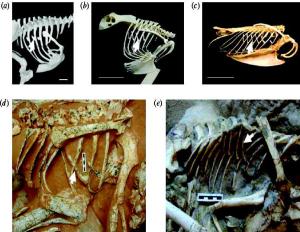I'd like to talk about birds today, but first a comedic aside: the first sentence of the review paper below mentions three lineages of flying vertebrates. I was having trouble coming up with the third, so I asked K, "Name a vertebrate that flies other than birds and bats." His responses were flying squirrels (not true flight), fish ("Swimming is like flying, right?"), and then he asked, "Are there any flying plants?" Oh dear. I swear he isn't as dumb as he looks on paper. You'd think that if he was going to leave the clade of vertebrates altogether, he'd at least come up with insects before jumping to hypothetical flying plants. But I digress. Actually, I still haven't figured out what the third lineage is, although I suspect that what we group together as 'bats' might actually be two distinct lineages. Or maybe the authors were referring to an extinct lineage that I'm not familiar with. I'll have to look that up later.
Birds have evolved incredibly unique and efficient respiratory systems to match the high energetic cost of locomotion by flight. Mammals, which, along with birds, are endotherms and thus have a relatively high metabolic rate compared to reptiles and amphibians, use a tidal respiratory system. Air enters and leaves the lungs from the same opening, and the entire volume of stale air is not expelled in one exhale. Thus, fresh air and stale air mix in the lungs every time you inhale, which causes decreased efficiency. In contrast, birds have a one-way flow of air through the lungs, aided by the use of air sacs. Air enters the lungs via posterior air sacs and leaves the lungs via anterior air sacs, ensuring one way flow (so that fresh and stale air do not mix) and, combined with cross-current exchange between the parabronchi and blood capillaries, more efficient gas exchange.

Source: http://www.peteducation.com/article.cfm?c=15+1829&aid=2721
Above is a rather simplified schematic of this process. Following one air packet: on the first inhale, the air travels to the posterior air sac. On the first exhale, the air passes through the lungs. On second inhale, the air leaves the lungs and enters the anterior air sac, and on the second exhale, the air leaves the body. (For more information on the physiology of avian respiration, this website is an excellent resource.)
Birds lack a diaphragm as seen in humans and other mammals. Instead, both inhalation and inspiration are active muscle processes, and respiratory rhythms must be coordinated with flight rhythms. The movement of the ribs and sternum must be coordinated so that the upward rebound of the sternum during the power stroke of flying is occurring at the same time as exhalation, since the net result is a decrease in thoracic cavity volume.

Source: http://people.eku.edu/ritchisong/skeleton.html
Recent interest in avian ventilation has focused on the significance of uncinate processes (UP), which are small caudo-dorsal projections from the ribs (see above figure) and are the subject of a recent review paper by Codd entitled Uncinate processes in birds: Morphology, physiology and function. UP are thought to function during inspiration, such that when a muscle attached to the UP contracts, it generates a torque that pulls the ribs forward and increases thoracic volume. Thus, the UP act as little levers for moving the ribs via muscle attachment. "Recent geometric modelling of the avian rib cage confirmed this lever-arm action and also demonstrated that having UP can increase the effective mechanical advantage by a factor or 2–4 for the movement of the ribs[.]" The UP have different morphologies in birds with different locomotor strategies, most likely due to the different breathing strategies necessary to maintain different types of locomotion. In some birds, the UP can also play roles in perching, egg-laying, and vocalization.
When the birds were resting on their sternum, thereby restricting normal movements, ventilation was achieved by an increase in activity of [the muscle attached to the UP] that resulted in a lateral flaring of the rib cage. It appears, therefore, that there is a switch in the mechanics of ventilation in birds associated with different postures. [...] Given our new understanding of the role of the UP in avian ventilation, and the fact that these processes are greatly reduced in species adapted to running or walking, it seems likely that the mechanics of ventilation in cursorial birds may be different from those of flying, diving or swimming species.
UP are also further evidence that birds are descended from therapod dinosaurs, as UP have been found in many Maniraptoran species.
Interestingly the UP in these dinosaurs are cartilaginously attached to the vertebral ribs (as they are in Apteryx and the Spheniciformes) suggesting that the ventilatory mechanics may be similar and also depend on enhanced flexing at the join to the rib. Given the fragmentary nature of the fossil record and the fact that UP are small bones easily lost during fossilisation or fossil excavation, it seems likely these processes are much more widely distributed.

Source: http://people.eku.edu/ritchisong/554notes1.html (Click to embiggen.)
Above is a comparison of avian uncinate processes (top) and those of Maniraptors (bottom). The presence of these morphologies in dinosaurs would suggest that the avian air sac system of breathing may have actually evolved before flight, instead of the other way around!
Codd, J. (2010). Uncinate processes in birds: Morphology, physiology and function☆ Comparative Biochemistry and Physiology - Part A: Molecular & Integrative Physiology, 156 (3), 303-308 DOI: 10.1016/j.cbpa.2009.12.005


















For the third group of flying verts, I think they mean pterosaurs (Wikipedia article)
ReplyDeletenice article and helpful for my dissertation! yeah the third flying vertebrates were the pterosaurs.
ReplyDelete